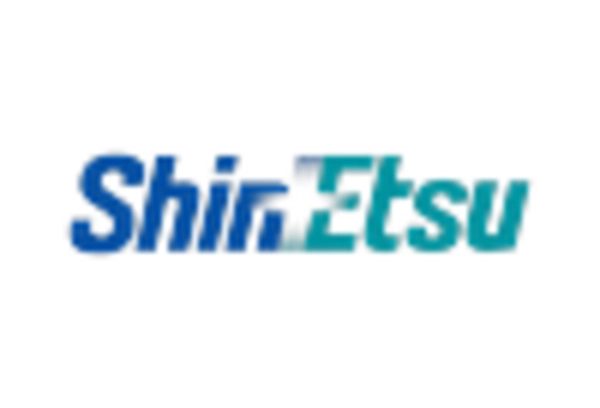Increased Focus on Miniaturization
The trend towards miniaturization in electronic devices significantly impacts the Semiconductor Polishing Pad Market. As manufacturers strive to produce smaller, more efficient components, the need for finer polishing techniques becomes paramount. This miniaturization trend is evident in various sectors, including mobile devices and wearables, where space constraints demand high precision in semiconductor fabrication. The market for semiconductor polishing pads is likely to expand as companies invest in advanced polishing technologies to accommodate these smaller geometries. Furthermore, the increasing complexity of semiconductor designs necessitates the use of specialized pads that can deliver the required surface quality, thereby driving growth in the Semiconductor Polishing Pad Market.
Rising Demand for Advanced Semiconductor Devices
The Semiconductor Polishing Pad Market is experiencing a surge in demand driven by the increasing production of advanced semiconductor devices. As industries such as consumer electronics, automotive, and telecommunications expand, the need for high-performance chips intensifies. According to recent data, the semiconductor market is projected to reach a valuation of over 500 billion dollars by 2025, which directly influences the polishing pad sector. The demand for precision and quality in semiconductor manufacturing necessitates the use of specialized polishing pads, which are essential for achieving the desired surface finish and flatness in wafers. This trend indicates a robust growth trajectory for the Semiconductor Polishing Pad Market, as manufacturers seek to enhance their production capabilities to meet the evolving technological landscape.
Technological Innovations in Polishing Processes
Technological innovations in polishing processes are driving advancements in the Semiconductor Polishing Pad Market. The introduction of new materials and techniques enhances the efficiency and effectiveness of polishing pads, allowing for better performance in semiconductor manufacturing. Innovations such as chemical-mechanical polishing (CMP) have revolutionized the industry, enabling manufacturers to achieve superior surface finishes. As the complexity of semiconductor devices increases, the demand for advanced polishing solutions is likely to grow. This trend suggests that the Semiconductor Polishing Pad Market will continue to evolve, with ongoing research and development efforts aimed at improving polishing technologies and materials.
Investment in Semiconductor Manufacturing Facilities
The Semiconductor Polishing Pad Market benefits from substantial investments in semiconductor manufacturing facilities. Governments and private entities are increasingly funding the establishment of new fabs to boost local production capabilities. This trend is particularly pronounced in regions aiming to reduce reliance on imports and enhance self-sufficiency in semiconductor production. As new facilities come online, the demand for high-quality polishing pads is expected to rise, as these pads are critical in achieving the necessary surface quality for wafers. The expansion of manufacturing capacity is likely to create a favorable environment for the Semiconductor Polishing Pad Market, as it aligns with the growing need for efficient and precise semiconductor fabrication.
Emergence of New Applications in Emerging Technologies
The Semiconductor Polishing Pad Market is poised for growth due to the emergence of new applications in fields such as artificial intelligence, machine learning, and the Internet of Things. These technologies require advanced semiconductor components that demand high-quality polishing processes. As industries adopt these innovations, the need for specialized polishing pads that can cater to the unique requirements of these applications becomes evident. The increasing integration of semiconductors in various devices is expected to propel the market forward, with projections indicating a compound annual growth rate of around 6% through the next few years. This growth reflects the Semiconductor Polishing Pad Market's adaptability to evolving technological demands.
















Leave a Comment